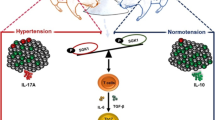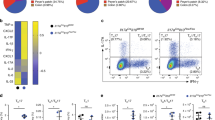Abstract
TH17 cells (interleukin-17 (IL-17)-producing helper T cells) are highly proinflammatory cells that are critical for clearing extracellular pathogens and for inducing multiple autoimmune diseases1. IL-23 has a critical role in stabilizing and reinforcing the TH17 phenotype by increasing expression of IL-23 receptor (IL-23R) and endowing TH17 cells with pathogenic effector functions2,3. However, the precise molecular mechanism by which IL-23 sustains the TH17 response and induces pathogenic effector functions has not been elucidated. Here we used transcriptional profiling of developing TH17 cells to construct a model of their signalling network and nominate major nodes that regulate TH17 development. We identified serum glucocorticoid kinase 1 (SGK1), a serine/threonine kinase4, as an essential node downstream of IL-23 signalling. SGK1 is critical for regulating IL-23R expression and stabilizing the TH17 cell phenotype by deactivation of mouse Foxo1, a direct repressor of IL-23R expression. SGK1 has been shown to govern Na+ transport and salt (NaCl) homeostasis in other cells5,6,7,8. We show here that a modest increase in salt concentration induces SGK1 expression, promotes IL-23R expression and enhances TH17 cell differentiation in vitro and in vivo, accelerating the development of autoimmunity. Loss of SGK1 abrogated Na+-mediated TH17 differentiation in an IL-23-dependent manner. These data demonstrate that SGK1 has a critical role in the induction of pathogenic TH17 cells and provide a molecular insight into a mechanism by which an environmental factor such as a high salt diet triggers TH17 development and promotes tissue inflammation.
This is a preview of subscription content, access via your institution
Access options
Subscribe to this journal
Receive 51 print issues and online access
$199.00 per year
only $3.90 per issue
Buy this article
- Purchase on SpringerLink
- Instant access to full article PDF
Prices may be subject to local taxes which are calculated during checkout




Similar content being viewed by others
References
Korn, T., Bettelli, E., Oukka, M. & Kuchroo, V. K. IL-17 and Th17 Cells. Annu. Rev. Immunol. 27, 485–517 (2009)
Aggarwal, S., Ghilardi, N., Xie, M. H., de Sauvage, F. J. & Gurney, A. L. Interleukin-23 promotes a distinct CD4 T cell activation state characterized by the production of interleukin-17. J. Biol. Chem. 278, 1910–1914 (2003)
Zhou, L. et al. IL-6 programs TH-17 cell differentiation by promoting sequential engagement of the IL-21 and IL-23 pathways. Nature Immunol. 8, 967–974 (2007)
Lang, F. et al. (Patho)physiological significance of the serum- and glucocorticoid-inducible kinase isoforms. Physiol. Rev. 86, 1151–1178 (2006)
Wulff, P. et al. Impaired renal Na+ retention in the sgk1-knockout mouse. J. Clin. Invest. 110, 1263–1268 (2002)
Salker, M. S. et al. Deregulation of the serum- and glucocorticoid-inducible kinase SGK1 in the endometrium causes reproductive failure. Nature Med. 17, 1509–1513 (2011)
Zhang, L., Cui, R., Cheng, X. & Du, J. Antiapoptotic effect of serum and glucocorticoid-inducible protein kinase is mediated by novel mechanism activating IκB kinase. Cancer Res. 65, 457–464 (2005)
Shelly, C. & Herrera, R. Activation of SGK1 by HGF, Rac1 and integrin-mediated cell adhesion in MDCK cells: PI-3K-dependent and -independent pathways. J. Cell Sci. 115, 1985–1993 (2002)
Yosef, N. et al. ANAT: a tool for constructing and analyzing functional protein networks. Sci. Signal. 4, pl1 (2011)
Brunet, A. et al. Protein kinase SGK mediates survival signals by phosphorylating the forkhead transcription factor FKHRL1 (FOXO3a). Mol. Cell. Biol. 21, 952–965 (2001)
Wei, G. et al. Global mapping of H3K4me3 and H3K27me3 reveals specificity and plasticity in lineage fate determination of differentiating CD4+ T cells. Immunity 30, 155–167 (2009)
Di Pietro, N. et al. Serum- and glucocorticoid-inducible kinase 1 (SGK1) regulates adipocyte differentiation via forkhead box O1. Mol. Endocrinol. 24, 370–380 (2010)
Essaghir, A., Dif, N., Marbehant, C. Y., Coffer, P. J. & Demoulin, J. B. The transcription of FOXO genes is stimulated by FOXO3 and repressed by growth factors. J. Biol. Chem. 284, 10334–10342 (2009)
Ciofani, M. et al. A validated regulatory network for Th17 cell specification. Cell 151, 289–303 (2012)
Berer, K. et al. Commensal microbiota and myelin autoantigen cooperate to trigger autoimmune demyelination. Nature 479, 538–541 (2011)
Sczesnak, A. et al. The genome of th17 cell-inducing segmented filamentous bacteria reveals extensive auxotrophy and adaptations to the intestinal environment. Cell Host Microbe 10, 260–272 (2011)
Stegbauer, J. et al. Role of the renin-angiotensin system in autoimmune inflammation of the central nervous system. Proc. Natl Acad. Sci. USA 106, 14942–14947 (2009)
Herrada, A. A. et al. Aldosterone promotes autoimmune damage by enhancing Th17-mediated immunity. J. Immunol. 184, 191–202 (2010)
Diakov, A. & Korbmacher, C. A novel pathway of epithelial sodium channel activation involves a serum- and glucocorticoid-inducible kinase consensus motif in the C terminus of the channel's alpha-subunit. J. Biol. Chem. 279, 38134–38142 (2004)
Loffing, J. et al. Aldosterone induces rapid apical translocation of ENaC in early portion of renal collecting system: possible role of SGK. Am. J. Physiol. Renal Physiol. 280, F675–F682 (2001)
Reich, M. et al. GenePattern 2.0. Nature Genet. 38, 500–501 (2006)
Storey, J. D., Xiao, W., Leek, J. T., Tompkins, R. G. & Davis, R. W. Significance analysis of time course microarray experiments. Proc. Natl Acad. Sci. USA 102, 12837–12842 (2005)
Chechik, G. & Koller, D. Timing of gene expression responses to environmental changes. J. Comput. Biol. 16, 279–290 (2009)
Acknowledgements
We thank D. Kozoriz for cell sorting and A. Waisman for providing Il17fCre mice. L. Zhou, D. Accili, J. Demoulin and K. Sato provided reagents. This work was supported by the US National Institutes of Health (NS030843, NS045937, AI073748 and AI045757 to V.K.K.; 1P01HG005062-01, 1P50HG006193-01 and DP1-OD003958-01 to A.R.; and K01DK090105 to S.X.); the National MS Society (RG2571 to V.K.K.); the Howard Hughes Medical Institute (A.R.); the Klarman Cell Observatory; Guthy Jackson Foundation; and the Austrian Science Fund (FWF, J 3091-B12 to T.T.).
Author information
Authors and Affiliations
Contributions
Author Contributions C.W, N.Y. and T.T. carried out experiments and wrote the manuscript. C.Z., S.X. and Y.K. carried out experiments. N.Y. analysed the data. A.R. and V.K.K. supervised the study and edited the manuscript.
Corresponding authors
Ethics declarations
Competing interests
The authors declare no competing financial interests.
Supplementary information
Supplementary information
This file contains Supplementary Figures 1-8, legends for Supplementary Tables 1-2 (see separate excel files), Supplementary Methods and additional references. (PDF 6814 kb)
Supplementary Table 1
This file contains the candidate selection in the Il23r–/– and Sgk1–/– data sets (see Supplementary Information file for full legend). (XLSX 62 kb)
Supplementary Table 2
The file contains the microarray data analysis (see Supplementary Information file for full legend). (XLSX 356 kb)
Rights and permissions
About this article
Cite this article
Wu, C., Yosef, N., Thalhamer, T. et al. Induction of pathogenic TH17 cells by inducible salt-sensing kinase SGK1. Nature 496, 513–517 (2013). https://doi.org/10.1038/nature11984
Received:
Accepted:
Published:
Issue Date:
DOI: https://doi.org/10.1038/nature11984
This article is cited by
-
Triggers for the onset and recurrence of psoriasis: a review and update
Cell Communication and Signaling (2024)
-
The underlying mechanisms of DNA methylation in high salt memory in hypertensive vascular disease
Scientific Reports (2024)
-
Mechanisms and consequences of sex differences in immune responses
Nature Reviews Nephrology (2024)
-
Meningeal interleukin-17-producing T cells mediate cognitive impairment in a mouse model of salt-sensitive hypertension
Nature Neuroscience (2024)
-
The regulation and differentiation of regulatory T cells and their dysfunction in autoimmune diseases
Nature Reviews Immunology (2024)



